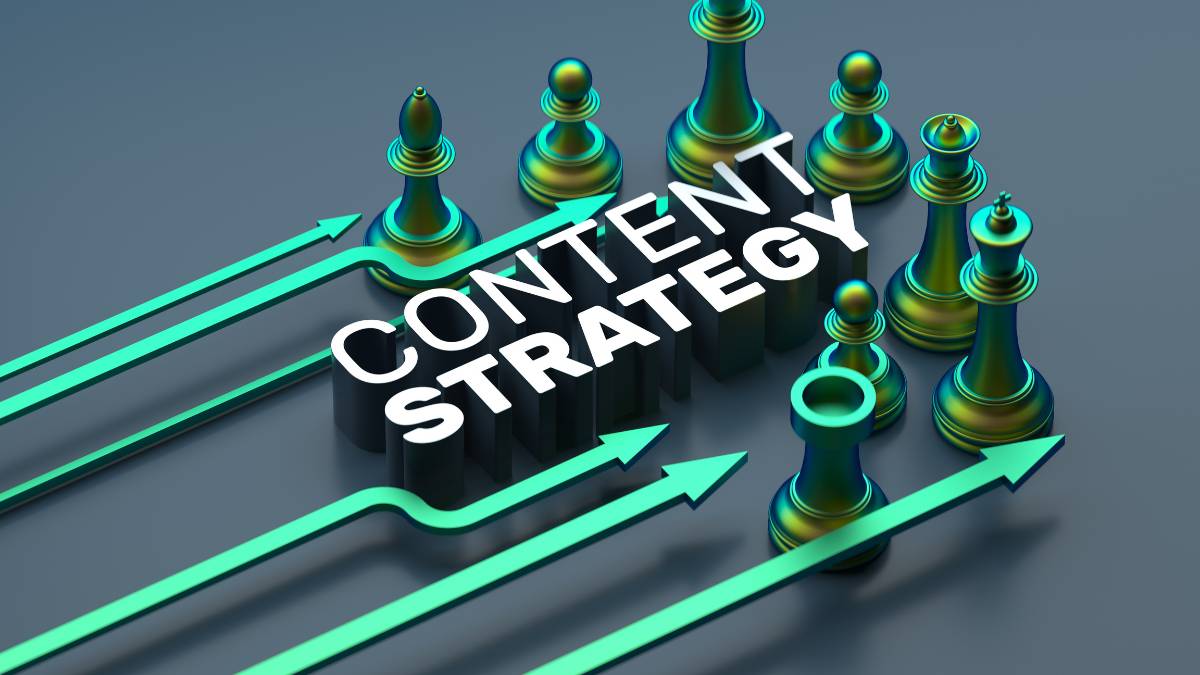Content has gotten kind of… overwhelming.
There’s just so much of it everywhere. Every brand, creator, startup, and side hustle is trying to say something online. Blog posts, Reels, tweets, carousels, email campaigns, podcasts, it’s never-ending. And if you’re someone trying to cut through all that noise with content that actually works, you’ve probably felt the pressure.
Now add AI into the mix.
Everyone’s either hyping it up like it’s going to fix all your content problems forever… or warning that it’s going to take your job. And the truth? It’s not really either of those extremes. AI is a tool. A powerful one, sure, but it’s only as good as the strategy behind how you’re using it.
That’s what we’re talking about here: AI content strategy. Not just using ChatGPT to draft a post. I mean a full-on approach to making your content better, faster, more targeted, without losing your human touch.
We’ll walk through what it is, why it matters, and how to actually use it without feeling like a robot.
Let’s rewind a bit first though…
Table of Contents
How Content Strategy Has Changed
Back in the day (and honestly, not that long ago), planning content meant sitting with a notebook or Google Doc, writing down topic ideas, maybe picking a few keywords, and just… starting.
You’d write blogs manually, schedule stuff on your own, check Google Analytics when you remembered, and hope for the best.
That kind of setup still works, sometimes. But the game’s changed.
Now, content needs to be:
- Personalized for your exact audience
- Published consistently across like 4-5 platforms
- Optimized for search AND social
- Measurable, scalable, and… yeah, still creative somehow
It’s a lot.
And that’s exactly where AI slid into the picture. Not to replace creativity, but to take some of the grunt work off your plate. Like the research. The keyword digging. The first drafts. The optimization. The scheduling. All the stuff that doesn’t have to be done manually anymore.
But again, and this is important, using AI here and there doesn’t mean you have a real strategy. If you’re just throwing prompts into tools without a bigger plan behind them, you’re going to get mediocre results at best.
So… What is an AI Content Strategy?
Think of it like this: An AI content strategy is just your regular content plan, but upgraded with smart tools that help you work faster, think clearer, and make better decisions.
You’re still the creative brain. AI’s just your helper.
It’s not about letting bots write everything for you. It’s about using AI to help with things like:
- Researching topics that people actually care about
- Organizing content ideas into smart clusters
- Writing rough drafts faster (so you’re not staring at a blinking cursor for hours)
- Optimizing for search without obsessing over SEO plugins
- Publishing content on time without scrambling at the last minute
When it’s done right, AI helps you stop wasting time on repetitive stuff, and spend more time doing the fun, strategic, creative parts of content.
Also Read: AI in Marketing Strategy
Why Use AI in Your Content Strategy?
Let’s break it down without the fancy buzzwords.
1. It Saves You Time (A Lot of It)
Creating content is a time suck. Research alone can take hours. Then writing. Then editing. Then optimizing. Then uploading, formatting, scheduling…
AI can’t completely do all that for you, but it can definitely speed things up. You can ask it to outline your blog posts. Or summarize your podcast transcript into a LinkedIn post. Or give you a list of 20 Instagram caption ideas based on one theme.
It’s like having an intern who never sleeps. (But you don’t have to teach them how to use Google Drive.)
2. It Helps Keep Things Consistent
If you’re creating content across platforms, blog, email, Instagram, YouTube, wherever, keeping a consistent tone can get tricky. Especially if you’re part of a team, or if you’re using freelancers or ghostwriters.
Some AI tools can actually learn your writing style. Others can scan your brand guidelines and help you stay on track. It’s not perfect, but it helps keep your brand voice from sounding like it has multiple personalities.
3. It Gives You Data You’d Probably Miss
Unless you’re one of those people who loves spreadsheets and dashboards (I am not), digging into performance data is… not fun.
AI tools can make this part way easier. They can highlight which blog posts are bringing the most leads, or tell you which Instagram content is quietly flopping. They can even recommend what to post next based on what’s already worked.
Basically, AI helps you stop guessing, and start creating with more purpose.
4. It’s Cheaper Than You Think
Hiring a full content team is expensive. So is outsourcing everything to an agency.
With the right stack of AI tools, one person can now do the work of a small team. That doesn’t mean you shouldn’t hire people, but it means even a small team can produce a LOT more without burning out.
Also Read: AI in B2B Marketing
The Real Pillars of an AI Content Strategy
Alright, let’s get into the meat of it. If you’re serious about building a content engine that runs with the help of AI, here are the key areas to focus on.
1. Understanding Your Audience (Like, Really Understanding)
This part hasn’t changed, content still needs to be written for someone. But AI can help you go way deeper than basic personas like “working professionals aged 25-34.”
There are tools out there that show you what your audience is searching for, what kind of content they like, when they’re most active, and even what other brands they engage with.
If you know what your audience actually cares about, everything else gets easier, the ideas, the headlines, the tone, all of it.
2. Coming Up With Solid Ideas (Without Going Blank)
We all hit that wall where you’re like, “What the hell should I post about this week?”
AI can help you get unstuck. It can scan your competitors, your old posts, trending topics in your industry, and toss you 20 or 30 ideas to work with.
You don’t have to use them all, but even skimming through a few can spark something better in your brain.
Tools like BuzzSumo or AnswerThePublic are great for this. You can also just use ChatGPT to bounce ideas around like it’s your brainstorming buddy.
3. Actually Creating the Content (Without Burning Out)
Let’s be real: writing every blog, caption, email, and landing page from scratch is exhausting.
AI writing tools don’t replace your voice, but they can absolutely help you get the ball rolling. A rough draft. A solid hook. A list of bullet points to expand on.
Then you go in, shape it, punch it up, add your personality, and you’re done way faster than if you started cold.
It’s the difference between staring at a blank page vs. editing something that’s already halfway there.
And don’t forget the optimization part. AI can help with:
- Writing SEO-friendly titles and meta descriptions
- Checking your keyword use (without stuffing)
- Making sure your structure is scannable for readers and search engines
Just please don’t let AI write full articles and publish them unedited. That’s how you lose trust, fast.
4. Sharing Your Content Without Losing Your Mind
You created the thing, now what?
This is where a lot of content strategies fall apart. People put so much energy into making the post, the video, or whatever… and then the distribution is basically “we’ll post it once on Instagram and hope it lands.”
AI can help you actually get your stuff seen. And consistently.
You can use tools that:
- Repurpose one blog into 10 tweets, a LinkedIn post, an email, and maybe even a script for a short-form video
- Schedule everything out across channels (with the right timing based on audience behavior)
- Remind you when to re-share evergreen stuff that’s still valuable
If you’re doing it all manually, it’s easy to forget or fall behind. AI tools don’t forget. And once you set them up, they quietly keep the train moving.
A few names to look into:
- Buffer or Planable for scheduling
- Hootsuite for multi-channel planning
- Taplio (if you’re heavy on LinkedIn)
- Repurpose.io (for turning long content into clips, quotes, etc.)
Again, these tools aren’t magic. You still need to guide the strategy. But once they’re rolling, they save you hours.
5. Figuring Out What’s Working (And What’s Just… Meh)
One of the biggest superpowers of using AI in your content strategy is this: you don’t have to guess anymore.
You can literally see what’s performing, and not just in a “likes and comments” kind of way. I’m talking deeper stuff:
- Which blog posts are driving traffic to your site?
- Which social posts actually led to email signups or product views?
- Which types of content fall flat, even if they get views?
AI tools can help you break this down without needing to become a data nerd.
For example:
- Google Analytics 4 (if you’ve set it up right) tracks user journeys and behaviors
- HubSpot can tell you what content led to conversions
- Some AI tools even suggest what kind of content to try next based on patterns
The key here is to listen to the data without letting it kill your creativity. Numbers are helpful, but they don’t always know when it’s time to try something fresh and weird.

Enroll Now: Advanced Digital Marketing Course
Let’s Talk Tools
There are so many AI tools out there right now. Honestly, it’s overwhelming. You try one, and suddenly five more pop up on Product Hunt promising to do it better.
So instead of listing 50 of them, here’s a shortlist of popular ones that actually help with different parts of content strategy, and are worth checking out.
For Idea Generation & Topic Research:
- BuzzSumo: See what’s trending in your niche
- SEMrush or Ahrefs: Keyword + competitor research
- AnswerThePublic: Great for finding questions your audience is asking
Also Read: 30 Keyword Research Tools
For Writing & Editing:
- Jasper or CopyAI: Generate drafts, hooks, and more
- Grammarly: Edit for clarity and tone
- Claude: Super smart for rewriting or summarizing
For SEO Optimization:
- SurferSEO or Clearscope: Helps you optimize for search engines without keyword stuffing
- Moz Keyword Explorer: Still great for SEO planning
- Content at Scale: Long-form writing with built-in optimization
For Scheduling & Distribution:
- Planable: Collaborative scheduling with a visual calendar
- Buffer or Hootsuite: Reliable for multi-platform posting
- CoSchedule: Good for content calendars and planning
For Analytics:
- Google Analytics 4: Must-have, even though it’s confusing at first
- HubSpot: Ties content to conversions (if you use their CRM)
- ContentKing: Real-time monitoring for content issues
No need to use them all. Start small. Try one or two in each category. See what fits your flow.
Also Read: 35+ AI Tools for Content Creation
So, How Do You Build an AI-Powered Content Strategy?
Let’s bring it all together in some actual steps. Not too fancy, just real, usable steps.
1. Start With Real Goals
What do you want your content to do?
Drive traffic? Bring in leads? Grow a following? Sell something?
Write those goals down. Be clear. Be specific.
2. Audit What You’ve Already Got
Look at your blog, social channels, YouTube, podcast, whatever you’ve been doing.
What’s working? What’s dead weight? What’s missing?
Use tools like Google Search Console or Ahrefs to see what’s getting traffic. You might be surprised.
3. Choose a Few Tools to Start With
Don’t get distracted by all the shiny options.
Pick one AI tool for research, one for writing help, one for scheduling, and one for analytics.
Test them for a month. See what saves you time. Ditch what feels clunky.
4. Get to Know Your Audience
Use AI to dig into who’s actually engaging with your stuff. What are they into? What are they searching? What keeps them up at night?
Segment them. Talk to them differently, depending on where they’re at in the buyer journey.
5. Build a Flexible Content Calendar
AI can help you fill it out with ideas, keywords, and themes.
But leave room to adjust. Real life happens.
6. Create → Optimize → Publish
Use AI to create drafts, check your SEO, and make sure everything’s scheduled to go live at the right time. Don’t forget to review and tweak with your human brain.
7. Watch the Numbers & Adjust
This is ongoing. Keep an eye on what’s working. Double down on that. Cut what’s not.
Use AI insights to help you spot trends early.
And repeat.
Also Read: How to Create an AI Marketing Strategy
Common Mistakes to Watch For
Even with great tools, people still mess this up.
1. Over-relying on AI
If you let AI do everything, your content starts sounding generic fast. Readers notice. Google notices. Keep a human touch in everything.
2. Using the Wrong Tools
Not every tool fits every team. Just because someone on LinkedIn swears by it doesn’t mean it’ll work for your setup. Test first.
3. Forgetting the Brand Voice
This one’s big. If you’ve got a strong tone or brand identity, AI can accidentally flatten it. Use AI-humanizing tools or just… rewrite and add your flavor manually.
Quick Summary Points
- AI content strategy isn’t just using tools.
It’s about building a system where AI helps speed things up, keeps you on track, and makes content smarter, without losing your brand voice or creativity.
- You still need to think like a human.
AI can help with research, writing, and scheduling, but final judgment, brand tone, and ideas that really hit? That’s still on you.
- Pick tools that fit your workflow.
Don’t chase the newest AI app every week. Stick with what saves you time and actually feels useful to you and your team.
- Audience understanding is everything.
AI helps you go beyond surface-level personas so you can create content that’s more relevant, more targeted, and more likely to perform.
- Watch what’s working, and adjust.
Let the data guide your tweaks. Use AI insights to spot trends and double down on what actually moves the needle.
Final Thoughts: Don’t Just Use AI, Work With It
The future of content isn’t AI versus humans, it’s humans using AI wisely. A strong AI content strategy helps you streamline the messy parts: idea generation, SEO, scheduling, analytics. But the stuff that really connects, the tone, the storytelling, the intuition, still needs you. When both come together, that’s when content becomes not just efficient, but impactful.
The goal isn’t to automate everything. It’s to use tools that give you more headspace to create, reflect, and refine. AI helps you scale. You make it meaningful.
And if you’re wondering whether this shift is just hype, studies show content marketers are already seeing better performance using AI for ideation, personalization, and optimization (source).
So take what you’ve learned here, start small, and build a system that works for you. One that feels natural, not forced. That’s where the real power of AI lives.
FAQs: AI Content Strategy
Q1: Do I need to know coding or tech stuff to use AI in my content strategy?
Nope. Most AI tools are super beginner-friendly now. If you can use Google Docs, you can use tools like Jasper or Grammarly.
Q2: Can I replace my content writer with AI?
Honestly, no. AI can help write drafts, but humans still do better when it comes to tone, storytelling, and anything creative or emotional.
Q3: What’s the best AI tool for content creators?
There’s no “best” for everyone. Try a few: Jasper for writing, SurferSEO for optimization, and Buffer for scheduling, then stick with what clicks.
Q4: Is AI content bad for SEO?
Not if you’re editing it properly. Google doesn’t care who wrote it, it cares about value, originality, and helpfulness. Just don’t publish raw AI text.
Q5: Is using AI cheating?
Not at all. It’s like using Grammarly or Canva, a tool that helps you work faster and smarter. You still bring the strategy.
Q6: How do I keep my content sounding like me if I’m using AI?
Edit everything. Add your own phrasing, opinions, little quirks. Over time, AI tools can also learn your tone if you feed them enough samples.

